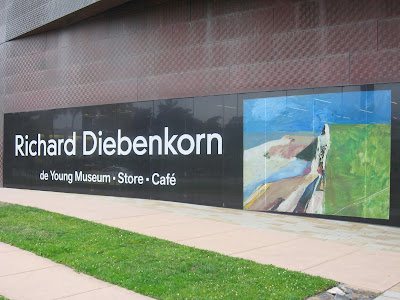Richard Diebenkorn was profoundly influenced by the nature and culture of the San Francisco Bay Area. Color, light and atmosphere played a significant role in many of the 20th century American artist's works that are on view in Richard Diebenkorn: The Berkeley Years, 1953-1966, at the de Young Fine Arts Museum in San Francisco's Golden Gate Park through September 29.
The exhibition, which had its debut in June, is the first of its kind to focus on this pivotal period in the career of this postwar American artist.
During his lifetime, Diebenkorn (1922-1993) achieved acclaim as one of the most significant and influential artists of California and of postwar America. His early work is associated with Abstract expressionism and the Bay Area Figurative Movement of the 1950s and 1960s.
At the beginning of this exhibition of more than 130 paintings and drawings that were assembled from museums and private collections across the country, we get to go outside the lines to get a feel for what's going on in Diebenkorn's mind as he shares his thoughts in Notes to myself on beginning a painting:
- Attempt what is not certain. Certainty may or may not come later. It may then be a valuable delusion.
- The pretty, initial position, which falls short of completeness, is not to be valued -- except as a stimulus for further moves.
- Do search. But in order to find other than what is searched for.
- Use and respond to the initial fresh qualities, but consider them absolutely expendable.
- Don't "discover" a subject -- of any kind.
- Somehow don't be bored -- but if you must, use it in action. Use its destructive potential.
- Mistakes can't be erased, but they move you from your present position.
- Keep thinking about Pollyanna.
- Tolerate chaos.
- Be careful only in a perverse way.
 |
| Richard Diebenkorn / Seated Figure with Hat, 1967, oil on canvas. |
As I walked through the exhibit rooms on a recent Friday evening, studying and absorbing Diebenkorn's artwork, my attention was drawn to several of the artist's quotes that were prominently displayed on the gallery walls. I took the time to read each of them carefully:
- "Abstract means literally to draw from or separate. In this sense, every artist is abstract ... a realistic or non-objective approach makes no difference. The result is what counts."
- "All paintings start out of a mood, out of a relationship with things or people, out of a complete visual impression."
- "I began to feel that what I was really up to in painting, what I enjoyed almost exclusively, was altering -- changing what was before me -- by way of subtracting or juxtaposition or superimposition of different ideas."
- "It was impossible to imagine doing a picture without it being a landscape; to try to make a painting space, a pure painting space, but always ending up with a figure against a ground."
After its San Francisco premiere, Richard Diebenkorn: The Berkeley Years, 1953-1966, will move to southern California and be on view at the Palm Springs Art Museum from October 26, 2013, to February 16, 2014.
To learn more about the Richard Diebenkorn exhibition at the de Young: http://diebenkorn.famsf.org/
Photograph of de Young Fine Arts Museum by Michael Dickens, 2013.To learn more about the Richard Diebenkorn exhibition at the de Young: http://diebenkorn.famsf.org/
Photograph of Richard Diebenkorn's Seated Figure with Hat, 1967, courtesy of Wikipedia Commons.

No comments:
Post a Comment